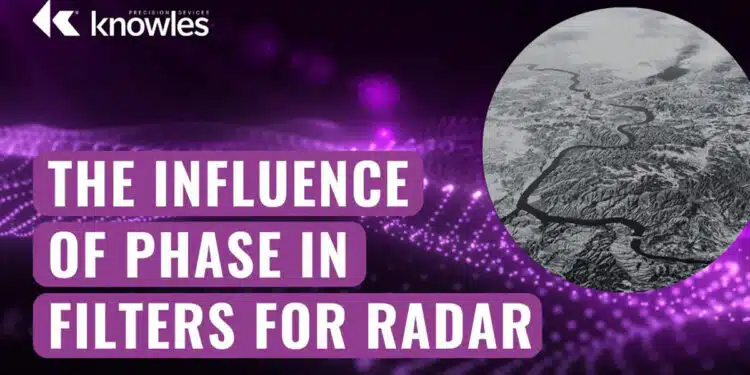This article based on Knowles Precision Devices blog explains role of phase-in filter in radar application.
In the first article RF Components for Radar Application, we provided an overview of the key functional units in radar, including duplexing, filtering, power amplification, waveform generation, low-noise amplification (LNA), receiving and analog-to-digital conversion (ADC). Since then, we’ve covered duplexing, switch filter banks and filters in detail: Filters in Radar Receivers.
In this post, we’ll discuss what phase can tell us about filter performance in radar applications.
Characterizing phase is an important, and often overlooked, aspect of assessing filter performance. Phase performance can be described in several different ways, including:
Phase Linearity
Also known as group delay, phase linearity describes how the phase of the frequency components of a signal change in relation to the frequency itself. Conceptually, group delay is the negative derivative of the phase of a signal in relation to angular frequency. Since real-world operating conditions aren’t ideal, variations over frequency are expected. Within a small bandwidth, group delay remains near-constant. In many applications, flat group delay is a desirable characteristic, so it’s best to select filters with a linear phase response.
When steering a beam in a phased array, phase settings that are independent of frequency help maintain the correct beam position, even when frequencies shift. For example, in image processing or digital data transmission, filters with a linear phase response maintain the signal’s wave shape and avoid phase distortion, since all frequency components experience the same amount of delay. Modulation schemes 256-QAM and 1024-QAM also rely on phase accuracy to achieve the desired bit error ratio (BER).
Phase Stability Across a Range of Temperatures
Radar leverages electromagnetic energy to accurately measure distances. The frequency content of radar pulses can span upwards of one gigahertz (GHz) of bandwidth. Pulses must be treated the same across that bandwidth or you can expect distortion to cause inaccuracies in radar range measurements.
The flatness of group delay over temperature is particularly important in phased array systems and synthetic aperture radar (SAR), which is used for creating high-resolution images of the surface of the Earth and other planets. In addition to more accurate measurements, minimizing phase variability over temperature reduces calibration requirements.
Phase Length Repeatability
Along with the flatness of group delay, consistency—over variables like temperature and frequency—is important in scenarios where achieving an appropriate null depth involves amplitude and phase tracking. Consistency and repeatability positively contribute to signal coherence, image quality and measurement accuracy.
Temperature-stable ceramics and precision thin film processes can minimize phase variation over temperature and drive repeatability in phase and frequency metrics from part to part and batch to batch.
At Knowles Precision Devices, we measure phase over environmental conditions as part of our acceptance test protocol (ATP) for all custom filters to ensure a high-quality product. Talk to an engineer.


































